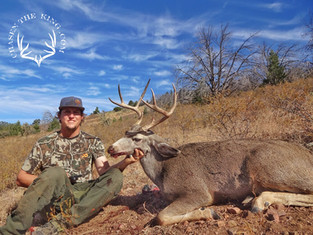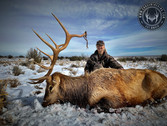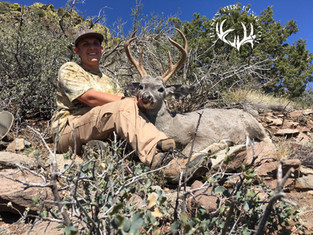I will try here to break down the way in which the AZ Draw System operates. Hopefully it will help you to better understand which hunts you should, or could be applying for based on your current bonus point levels. All of the information on the draw and hunt statistics can be found through the AZGFD website, GoHunt, or Hunters Trailhead. There are other great resources out there, use them to your advantage.
Bonus Points are accrued (1) per unsuccessful draw cycle, (1) permanent point for successful completion of Hunter safety, and (1) loyalty point after 5 consecutive years of applying for a valid hunt number or bonus point only. The loyalty point will remain as long as a valid application is summited for that species.
Non-Residents cannot draw more than 10% of any hunt number, for Elk, Deer, Antelope, Spring Bear, Javelina, and Turkey. For Buffalo and Bighorn Sheep Non-Residents cannot draw more than 10% of the total combined tags. Of the NR 10% Cap no more than half or 5% of the total can be allotted during the Bonus Pass and no more than 5% can be allotted during the Random Draw Passes. NRs may draw from 0-10% of the tags; they are not procedurally guaranteed 10%. However, statistically NRs will meet the 10% cap on High Demand hunts.
The Draw is conducted in three rounds. The first round is the Bonus Pass. The second is the 1-2 Pass. The third and final round is the 3-4-5 Pass. Rounds two and three are regarded as Random Draw. Each round of the draw assigns a new random number.
ROUND 1: BONUS PASS
Q: So what is the purpose of Bonus Points and how do they influence my draw odds?
A: The First round or Bonus Pass allots 20% of the amount of tags of each hunt number for Elk, Deer, Antelope, Spring Bear, Javelina, and Turkey. For Buffalo and Bighorn Sheep this pass allots 20% of the total combined tags. In this round no more than 5%of the tags can be given to Non-Resident applicants. No less than 15% will go to Resident applicants.
The Breakdown:
TOTAL of 20% = ((0-5% = Non-Resident)+(20-15% = Resident))
Q: Who gets the tags in this round?
A: Tags in this round are given to Max Bonus Point holders.
Max Bonus Points explained:
Maximum point levels vary based hunt demand. A late Cow Elk hunt may have no applicants with more than 7 points applying, while an early rifle Bull Elk hunt may have no applicants with more than 23 points applying. The MBP pool would include all point holders with 7 points or less and 23 points or less respectively. If the 20% allotment is not met by the total number of applicant with 7 or 23 points then the next lowest point pool is selected in descending order. Therefor point holders with 6 or 22 points are next in line then 5 or 21. This follows until the 20% tag cap has been filled for each hunt number, excluding Bighorn Sheep and Buffalo which is 20% of the total combined tags. See NR percentage breakdown above.
Q: Which choices matter in this round?
A: Only, your first and second choices are looked at in this round. If you are in the Max Bonus Point Pool for those particular hunts. First choice will be looked at first. If tags are available you will be drawn for you first choice. If not, your second choice is looked at. If tags are available, you will be drawn for your second choice. If tags are not available for either choice you get bumped, the process then continues with the next lowest numbered applicant. Note that if you do not fall into the Max Bonus Point Pool for one or both of your choices those choices will not be considered in this round of the draw.
At the end of this round only 20% of the tags have been drawn, 80% of the tags remain.
ROUND 2: THE 1-2 PASS “Random Draw”
This is the first portion of the draw that ANY APPLICANT CAN BE DRAW! At the beginning of the 1-2 pass everyone not drawn in the Round 1 Bonus Pass is put back into the hat and assigned NEW DRAW NUMBERS.
Q: Do my Bonus Points have any effect in the Random Draw Rounds?
A: Yes, in these rounds your odds of being assigned a low number are weighted. An applicant with 18 Bonus Points has 18 chances to be assigned the lowest number possible, only the lowest is kept. An applicant with 2 points would only have two chances to draw a lower number. However, ANY APPLICANT CAN DRAW A LOW NUMBER this is why it get the name Random Draw.
Q: Which choices matter in this round?
A: Only, your first and second choices are looked at in this round. First choice will be looked at first. If tags are available you will be drawn for you first choice. If not, your second choice is looked at. If tags are available, you will be drawn for your second choice. If tags are not available for either choice you get bumped, the process then continues with the next lowest numbered applicant.
The remaining Non-Resident tags (5% of total) will be allocated in the 1-2 pass followed by the 3-4-5 pass.
This is the round that fills the vast majority of tag allocations. Statistically all High Demand hunts will be filled during the 1-2 pass at “Random.” This is also the round where hunters with 0 points may draw Trophy or High Demand Tags. Every year we see low point holders drawing Bighorn Sheep tags, 13B Strip Mule Deer tags, or Rifle Antelope tags. These incidences occurred because of the 1-2 pass draw structure and its Random Draw characteristic.
ROUND 3: THE 3-4-5 PASS “Random Draw”
The final round of the draw follows the same process as the second round. ONLY tags remaining after the 1-2 pass can be drawn in this round. Another name for this round in regards to Elk could be the “Cow and late Archery Bull Round.”
You statistically WILL NOT DRAW any High Demand tags in this round. At this point there has already been far more than enough applicants to fulfill 100% of the tags for High Demand units in both the Bonus Pass and the 1-2 Pass. If you are applying for the Strip, Kaibab, Early Rifle Bull, December Rifle Coues, Rifle Antelope, or similar High Demand hunt you CANNOT statistically draw them with a 3rd 4th or 5th application choice! …The numbers don’t lie…
Q: Which choices matter in this round?
A: Only, your third, fourth, and fifth choices are looked at in this round. Third choice will be looked at first. If tags are available you will be drawn for you third choice. If not, your fourth choice is looked at. If tags are available, you will be drawn for your fourth choice. If not, your fifth choice is looked at. If tags are available, you will be drawn for your fifth choice. If tags are not available for any choice you get bumped, the process then continues with the next lowest numbered applicant.
After this round the draw if complete and almost all of the tags have been allocated.
LEFTOVER TAGS:
Any hunt that did not have sufficient numbers of applicants to fill during the draw will have Leftover Tags. Check out AZGFD’s website after the draw if you want to acquire one of those. This is the option for anyone who wants to hunt ever year and NOT LOSE BONUS POINTS. Non-Residents and Residents alike, this is your option to chase rifle deer every season! If you want to up your odds on a tough hunt hire an Outfitter, some of these tags are very under rated.
HOW TO APPLY:
Hopefully you have understood the process up to this point. Now lets look at some examples on how to apply in order to optimize your odds at drawing the best tag possible and address some strategy errors, one of which I pointed out at the end of Round 3.
Q: I don’t have any points, what should I apply for?
A: Basically the answer is that it depends mostly on what hunt you want to have. If you like shooting Cow Elk for meat, go for it, and apply all 5 choices for cow hunts. This write up isn’t for the opportunity hunter but for the optimizing hunter. If you want the best hunts possible take into consideration how the draw is conducted and pick quality hunts, knowing your statistical chances are low until you accrue several years worth of points. If you want to experience quality hunts odds are you need to get comfortable waiting, unless you’re lucky in the Random Draw.
Five Points is where I see the odds for most hunts getting into the “I might draw it” category. However that may be 10,15, or 20 depending on the hunt. Do your homework. Use your resources and find accurate draw odds that account for your individual bonus point levels. The AZGFD Regulations show the most basic draw odds, at the very minimum look at those! Note however that for Bighorn Sheep you CANNOT draw the top tier hunts without Max Points. Sorry, but you will not draw 22 or 24b Desert with anything other than Max Points for reasons explained above.
Q: What happens if my First choice is a hunt I CANNOT draw in the Bonus Pass, but my Second choice is a hunt that I CAN draw in the Bonus Pass?
A: During Round 1 your first choice would not be considered in this situation. Your second choice may guarantee you that tag if and only if the 20% Bonus Cap has not been met when your number is chosen.
Q: Should I only pick a first choice if I have max points? What about picking the same hunt for 1 and 2?
A: Sure, if that is the only tag you are willing to take, then don’t pick a second choice. Putting the same hunt number for first and second choice would make no difference… not really sure who came up with that idea but I have heard it several times.
Q: Should I pick Low Demand hunts for choices 3-4-5?
A: It depends. NOT if you are saving your points for a quality hunt! Once you draw you will lose all of your points for that animal. If you don’t care about good hunts this isn’t for you. If you want to go hunting but wish to keep your points until you draw a quality tag then pick up a Leftover Tag after the draw has taken place. Leftover Tags DO NOT USE BONUS POINTS.
Q: How do I draw a High Demand tag?
A: You wait and accrue points, or get lucky! You have a better chance the more you wait. At a certain threshold you are guaranteed a tag statistically, but you might have to live 25 more years to get there…
Q: I have X amount of points can I draw a tag?
A: Yes, at any given point level for a Resident you can draw, certain hunts can be projected as guaranteed, Non-Residents must be far more selective due to the NR 10% Cap, and consider the Bonus Pass/Random Draw split.
Q: I’m a Non Resident, how can I go hunting in Arizona?
A: Yes, because of the cap the odds are not favorable for any of the top tier hunts for NRs. With the 5%/5% split, it is now statistically possible, however not plausible for a NR to draw ANY TAG. The numbers are still against Non-Residents; you will just have to get comfortable if you want a High Demand draw tag. THERE ARE OTHER OPTIONS for NRs and Residents alike. Lower Demand tags will allow you to come hunt 3-4 times in AZ while your buddies wait for their Once-in-a-Lifetime tag, you can have several Bulls on the wall and years of full freezers while other hunters wait. LEFTOVER TAGS are a great way to go hunt, particularly for deer. These do not use up your Bonus Points. Over-The-Counter Archery tags also allow for very liberal time frames and hunter opportunity. There are hunts that NRs can do every year in Arizona with great success.
Q: What about applying multiple hunters on the same application, up to 4?
A: We manage to get one or two good tags a year by avoiding this tactic. Apply everyone, friends or family, on separate applications. If you apply with multiple people the sum of you Bonus Points is averaged. If one hunter has 10 points and the second applicant has 0 points the effective point value going into the draw would only be 5 points. This helps one applicant and hurts the other. There must also be enough tags available for everyone on the application to draw a given hunt, if there is not your application gets bumped in the same manor as would happen if all of the tags had already been allotted. Apply on individual apps, odds are always better that at least one of you will draw.
Q: I can't apply my child until they are 10 years old, will they ever be able to draw a High Demand tag as the hunter pool grows?
A: Yes, Residents will of course have a huge advantage in the Random Draw here. Another long term strategy is to apply non-hunting Grandparents or Parents for Bonus Point Only, then "cash in" the points on a tag once your child is of age to hunt. In AZ the big game hunting age is 10 with Hunter Safety, 14 without (make them take it don't be that parent). A tag may be transferred to a minor child only from a Parent or Grandparent. Check out the AZGFD Regulations for more information on tag transfers. This is a great way to get your children several good tags at a young age, invest in them.
Our system works as intended, know and understand it so that you can use it to your advantage. Everyone can get a tag, eventually. Pick hunts that fit your needs, point levels, and schedules. Find the best opportunity. MAKE SURE YOU ARE USING YOUR ARIZONA BONUS POINTS TO THEIR POTENTIAL! If you would like to hunt with the CHASE'N THE KING team, check out the annually updated application recommendation pages under the "Hunts" menu at the top of the website for our preferred Elk, Coues Whitetail, and Mule Deer guided hunt selection.
If you have further questions, need help with your strategy, options, or need help understanding the numbers, send me an email or text, and I would be happy to help you with your application process. If you contact us, please provide your name, species of interest, number of bonus points, and any other information that will help us select the best hunt options for your hunting experience.
Dillon Currie
(623) 606-3364
hunts@chasentheking.com
www.CHASENTHEKING.com



































































